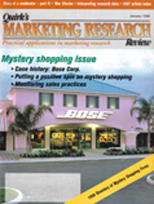Editor’s note: James H. Porchey is president of Porchey Research Inc., St. Louis.
Amid the downsizing, reorganization and merger frenzy in today’s corporate America, staying in close touch with employees’ opinions and ideas is an essential component of bottom-line success. Whether or not they are directly affected by those changes, employees are increasingly sensitive about company direction and what role they will play in achieving corporate goals. Knowing what employees think about their company, its products and services, and the key issues it faces are fundamental needs in a changing and highly competitive marketplace. Also, understanding how best to educate and motivate employees to help reach corporate objectives is essential to overall success.
More and more, businesses are turning to action-oriented employee research as a way of learning about workers’ perceptions and suggestions and developing action plans to improve their effectiveness. A variety of methods exist to collect employees’ views, including telephone, in-person interviews, E-mail and mail surveys. Three "C’s" - cost, confidentiality and convenience - make mail the favored approach.
A major part of an employee survey is deciding which issues to examine. Typically, interviews are conducted with selected management and non-management employees to pinpoint key workplace issues from a variety of perspectives. Most often, those issues tend to center on items such as:
- overall images of the company;
- perceived company strengths and weaknesses;
- internal communications, both actual and preferred;
- key characteristics of the company, e.g., responsiveness, honesty, innovation, trustworthiness, industry leadership, etc.;
- awareness, knowledge and feelings about company products and services;
- understanding company goals and direction;
- resources needed to perform the job effectively;
- ways employees indirectly market the company and its products and services -- and ways they can do it better;
- overall ratings of the company, morale, teamwork, management quality and employee quality; and
- demographic information.
Once the key issues are agreed upon, a questionnaire is developed. The questionnaire should be easy to use and understand. Also, special care is taken to ensure that question wording and sequence are objective and not slanted to elicit a particular response.
After the questionnaire is designed and approved, it is sent to employees through the company mail system or directly to workers’ homes with a letter from the company president or CEO explaining what is being done and why. The letter also confirms that answers will be reported only in their composite form, that all individual responses will be confidential, and the questionnaire can be completed conveniently either at home or at work.
To help ensure much-needed confidentiality, the completed pre-stamped and addressed questionnaire is mailed directly back to the outside firm selected to conduct the research. Once the questionnaires are completed and returned, the data is analyzed using statistical programs that allow crosstabulations, correlations and factor analysis.
These analytical procedures help the company identify differences between the various types of employees studied and which issues are most closely associated with overall ratings. This information helps set clear priorities that become the foundation of an action plan to be implemented in response to survey findings.
Action plan
Developing and carrying out an action plan to respond to research results are two critically important parts of the employee research process. Those steps lead to improved employee performance and reaffirm for workers that their views and ideas are valued and acted upon.
Specific action plans depend, of course, on survey results. Yet, the following are the types of recommendations for action such research might suggest.
- Build on perceived company strengths by featuring them regularly in corporate communications, and take needed steps to lessen perceived weaknesses.
- Use the types of internal communications media employees prefer, and ensure employees receive the types of information they need to do their jobs effectively.
- As a company, be responsive, honest, innovative, trustworthy and an industry leader, and make sure employees are aware of company performance in each of these areas.
- Make sure employees are aware of and knowledgeable about company products and services, and inform employees about company goals and direction.
- Ensure employees have the resources they need to do their jobs effectively.
- Educate employees about ways they can indirectly market the company as they interact with people beyond the workplace.
- Pinpoint ways to improve morale, teamwork, and management and non-management quality.
- Target specific employee groups, and construct appropriate messages for each, using demographic characteristics.
After implementing the action plan, it is important to establish a method of evaluating its success. Most often, that is a follow-up survey similar to the initial benchmark employee study to provide a before-and-after picture of the workplace. That data, along with financial and other pertinent information, is used to help evaluate company success.
Investment pays off
While employee research requires an investment of time, money and energy, a well-executed survey, and the actions that result from it, can pay off in improved morale, better customer service and an enhanced company image.
